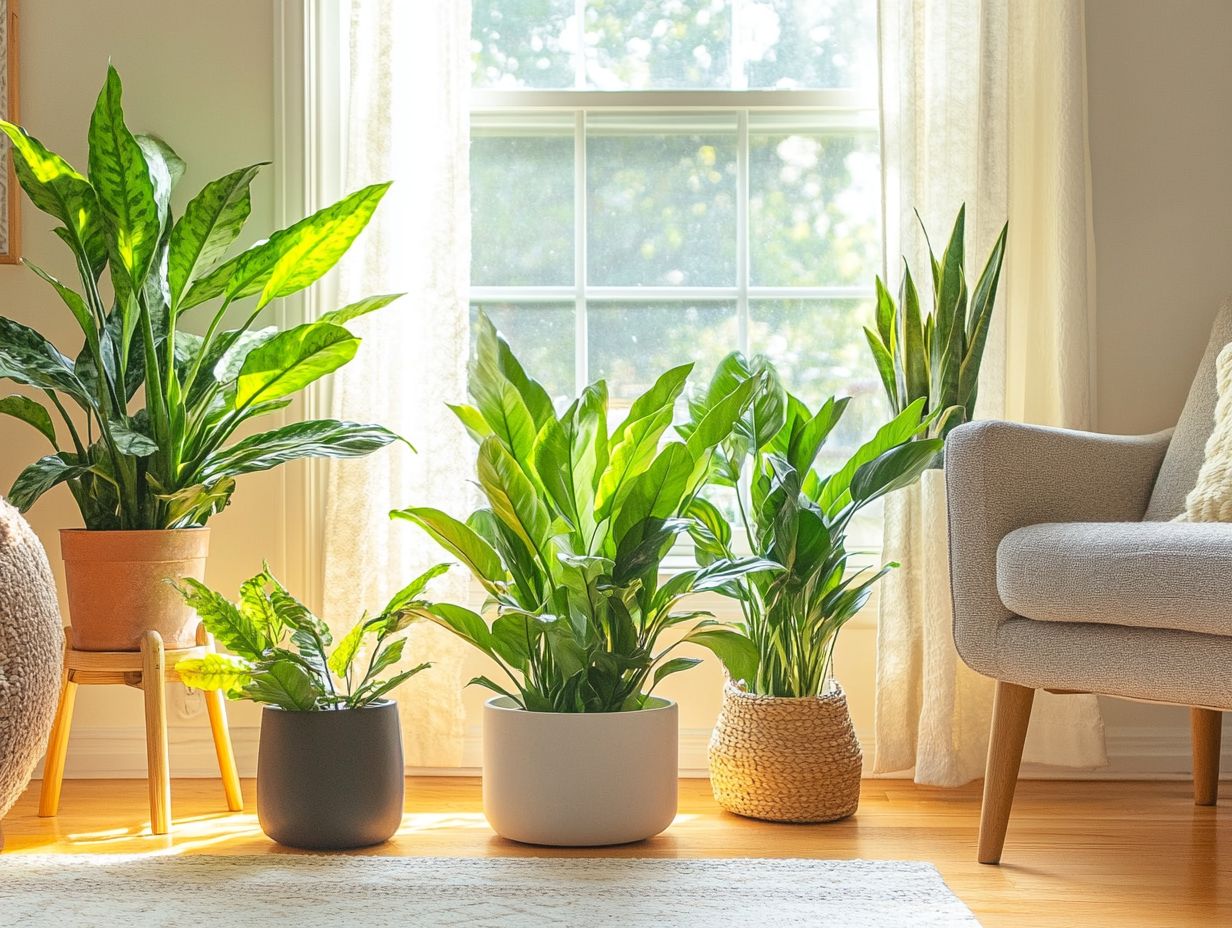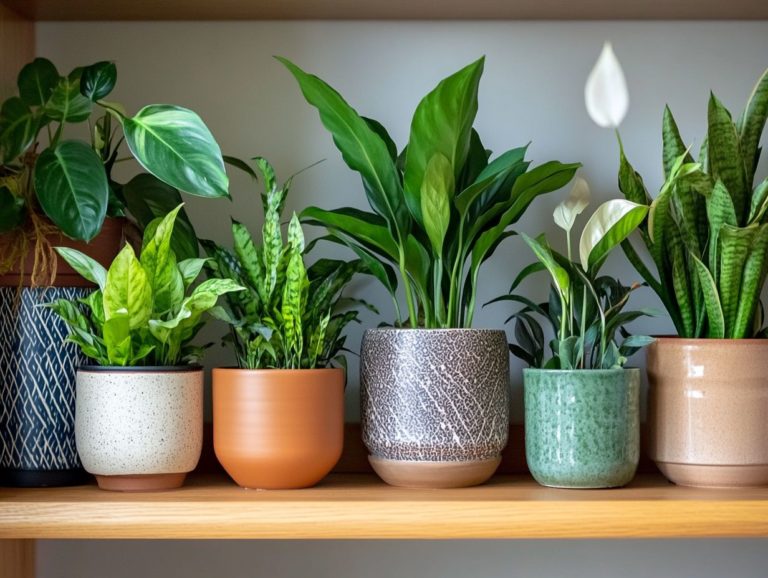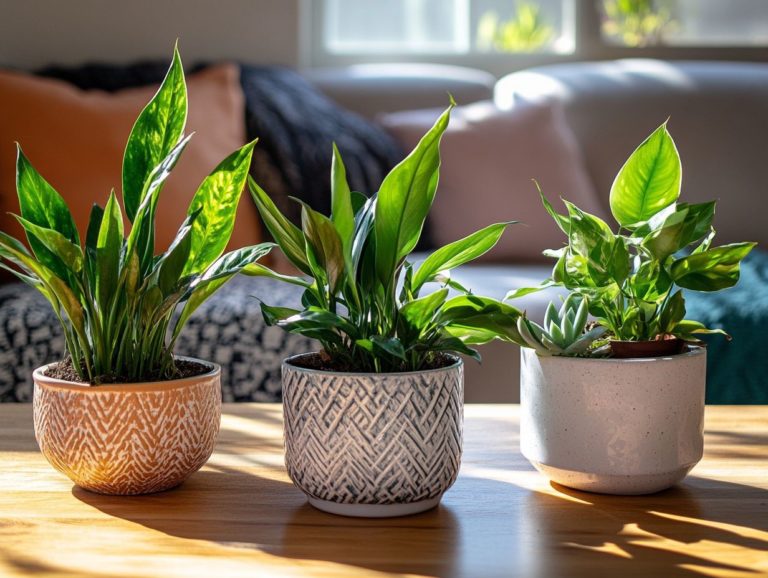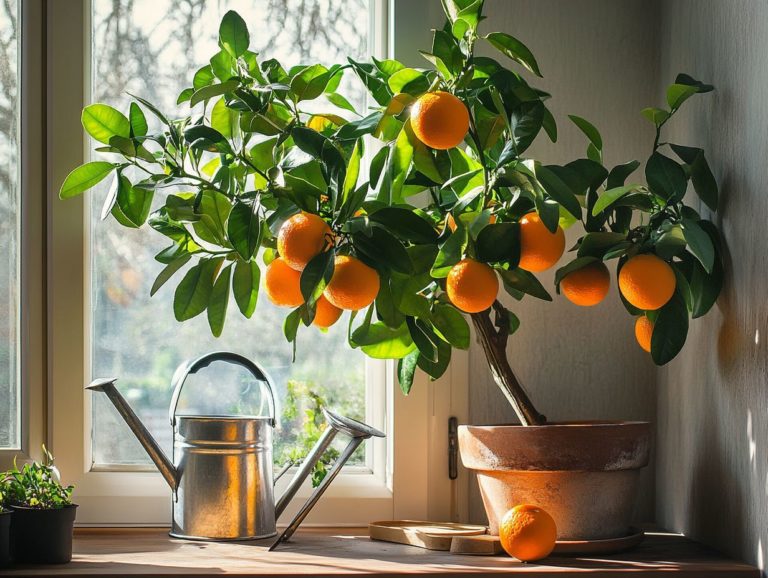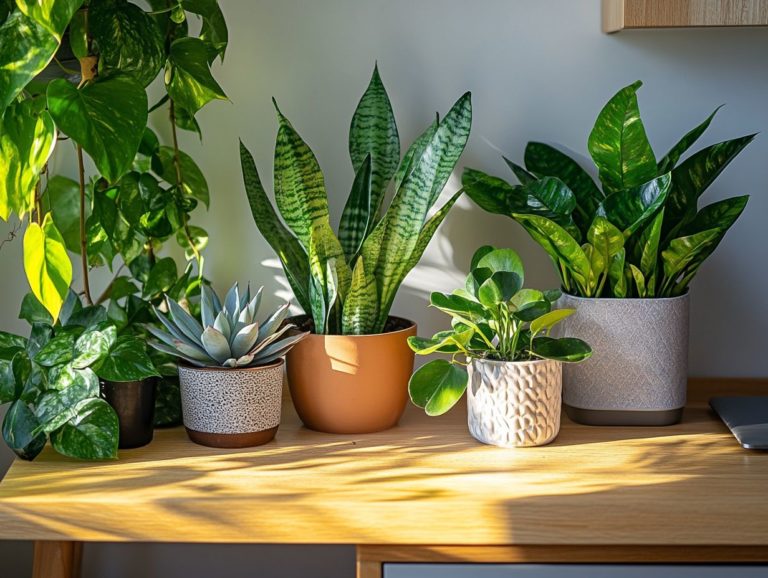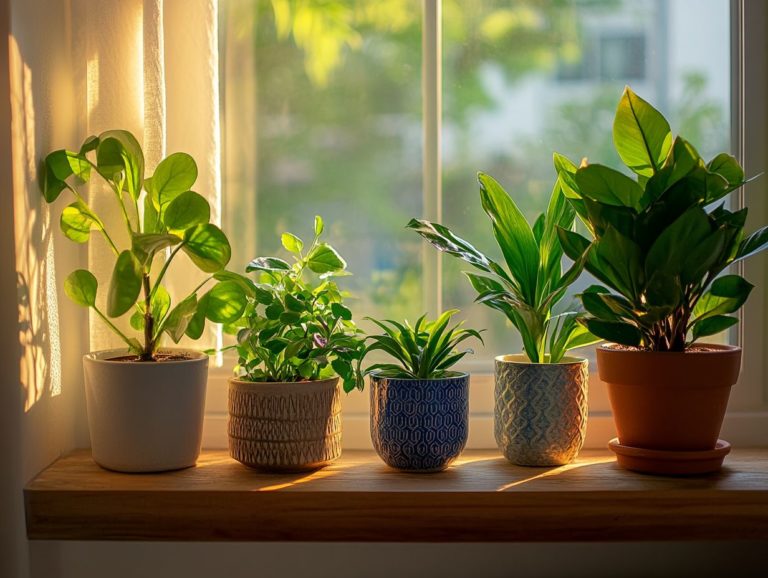Top 5 Indoor Plants for Natural Light
Indoor plants do more than just elevate the aesthetics of your living space; they also foster a healthier, more vibrant atmosphere within your home. Let’s explore how to bring life and color into your home with these fantastic plants!
This article delves into the top five indoor plants that flourish in natural light, featuring the likes of the Snake Plant, Aloe Vera, and Peace Lily. It also covers the benefits of adding indoor plants to your decor, guides you on assessing your home s natural light, and provides essential tips for caring for these verdant companions.
Whether you re a seasoned plant enthusiast or a budding green thumb, you ll uncover ways to enrich your home with the perfect touch of greenery.
Contents
- Key Takeaways:
- 1. Snake Plant
- 2. Aloe Vera
- 3. Peace Lily
- 4. Spider Plant
- 5. Jade Plant
- What Are the Benefits of Having Indoor Plants?
- How Can Natural Light Affect Indoor Plants?
- What Are the Different Types of Natural Light?
- How Can One Determine If Their Home Has Enough Natural Light?
- What Are the Key Factors to Consider When Choosing Indoor Plants for Natural Light?
- How Can One Care for Indoor Plants That Require Natural Light?
- Avoid These Common Mistakes When Growing Indoor Plants!
- Can Indoor Plants Survive Without Natural Light?
- How Can One Incorporate Indoor Plants into Their Home Decor?
- What Are the Best Places in a Home to Display Indoor Plants Requiring Natural Light?
- What Are the Benefits of Having a Variety of Indoor Plants in a Home?
- Frequently Asked Questions
Key Takeaways:
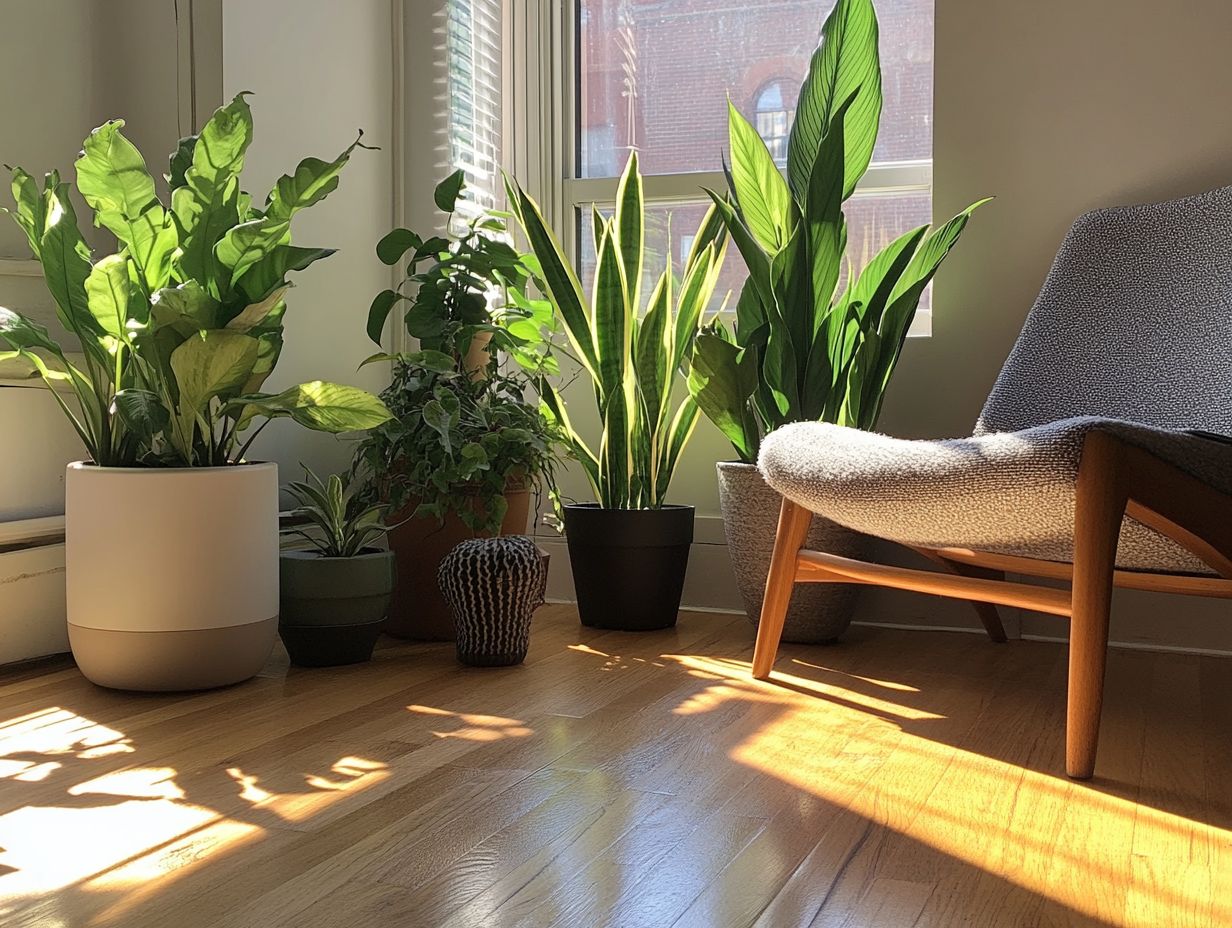
- Indoor plants improve your d cor and clean the air.
- Choosing the right plants that thrive in natural light is key for their growth.
- Easy-care plants that thrive in natural light are snake plants, aloe vera, and peace lilies!
1. Snake Plant
The Snake Plant, or Sansevieria, is truly a remarkable houseplant that thrives even in low-light conditions. This makes it an ideal choice for bathrooms or those cozy, dimly lit corners of your home.
Originating from the arid regions of West Africa, it has adapted beautifully to survive on minimal water. It needs only the occasional drink typically every two to six weeks based on humidity and light levels.
The Snake Plant has thick, upright leaves that enhance your space. It also purifies the air, filtering out toxins while you sleep.
Compared to other low-light options like pothos or spider plants, it stands out for its low watering needs and remarkable tolerance for neglect. This makes it an excellent choice for anyone who may not possess a particularly green thumb.
With proper well-draining soil and a touch of indirect sunlight, this resilient plant can effortlessly elevate any area of your home, from the living room to the bedroom.
2. Aloe Vera
Aloe Vera stands out as a remarkable houseplant, captivating not only with its striking appearance but also with its impressive healing properties. This makes it a favored choice among indoor gardening enthusiasts.
This succulent serves as a natural remedy for minor burns and skin irritations. You can harness its medicinal benefits right in your own home.
Aloe thrives with remarkable ease, requiring minimal care perfect for those of you with bustling lifestyles. It enjoys bright, indirect light but also shows impressive adaptability to lower light conditions.
In terms of watering, keep it infrequent typically every three weeks ensuring the soil dries out completely between sessions to avoid the perils of overwatering.
For propagation, simply remove small new plants that grow from the main plant and nestle them in well-draining soil. They ll root effortlessly, allowing you to expand your gardening collection with finesse.
3. Peace Lily
The Peace Lily is a captivating low-light indoor plant, celebrated for its elegant white blooms and remarkable ability to thrive in various lighting conditions while purifying the air.
This botanical gem is not just a visual delight; it boasts an impressive flowering cycle, typically showcasing its blooms during the spring and summer months.
Its natural air-filtering properties make it a top choice for those who prioritize health and well-being. To help your Peace Lily thrive, maintain consistent watering, keeping the soil moist but never soggy.
Additionally, optimal humidity levels are essential. A humid environment can significantly boost its growth and blooming potential, making the Peace Lily an ideal choice for infusing greenery into your indoor spaces.
4. Spider Plant
The Spider Plant is a resilient houseplant that effortlessly adapts to areas with little light. It s a beloved choice for both novice and seasoned plant enthusiasts.
This hardy gem boasts long, arching leaves adorned with vibrant green hues and striking white or yellow stripes. Not only does it elevate the aesthetic of any indoor space, but it also serves as a natural air purifier, filtering out harmful toxins.
For optimal care, plant it in well-draining potting soil and practice moderate watering. Allowing the top inch of soil to dry out between watering sessions is essential.
As the Spider Plant matures, it produces delightful offshoots, affectionately known as pups . These can be easily propagated in water or soil, enabling you to expand your plant collection effortlessly while ensuring the health of the original plant remains intact.
5. Jade Plant
The Jade Plant, or Crassula ovata, is a prized succulent celebrated for its lush, fleshy leaves and remarkable ability to thrive in low light. It often symbolizes good luck and prosperity, making it a popular choice for many.
This enchanting plant holds a significant place in various cultures, particularly within Asian traditions, where it s frequently linked to wealth and success.
To ensure your Jade Plant flourishes indoors, it s essential to grasp its care requirements. Approach watering with a discerning eye; allow the soil to dry out between waterings to avoid root rot, a condition where plant roots decay due to excess moisture.
In terms of light, the Jade Plant prefers bright, indirect sunlight but can adapt to lower light levels. Regularly rotating the plant will help maintain balanced growth and keep those leaves looking vibrant.
With a little love and attention, your Jade Plant will thrive beautifully!
What Are the Benefits of Having Indoor Plants?

Having indoor plants elevates your living space in ways you might not have imagined. They enhance air quality, add moisture, and create a soothing atmosphere that fosters well-being and boosts productivity.
These greens also filter pollutants and improve oxygen levels. They elevate the aesthetic appeal of any room, transforming dull corners into vibrant, inviting retreats. The presence of indoor plants can evoke a sense of tranquility, helping to mitigate stress and anxiety as they provide a serene focal point amid the daily hustle.
Many find that being surrounded by greenery sparks heightened focus and creativity, making plants an invaluable asset in home offices or study areas.
Integrating plants into your environment nourishes both body and mind, enriching the overall experience of your living space. So, why not choose a plant for your home or office today?
How Can Natural Light Affect Indoor Plants?
Natural light is essential for the health and vitality of your indoor plants. It shapes their growth patterns and overall well-being, especially for those that thrive under specific lighting conditions.
Take sun-loving plants like succulents and cacti, for example. These green beauties revel in bright, direct sunlight, often needing six or more hours each day to truly flourish and showcase their vibrant colors. Not only do they thrive with ample light, but they also purify the air, bringing refreshing energy to your space. To discover the top 5 indoor plants for seasonal changes, consider adding a few to enhance your indoor environment.
On the flip side, low-light tolerant plants, such as snake plants and pothos, can easily adapt to dimmer environments, making them perfect companions for offices or cozier, darker rooms. Understanding how different plants respond to varying levels of natural light is crucial for any plant enthusiast. For those looking to enhance their indoor spaces, exploring the top 5 tropical plants for indoor environments can provide valuable insights. This knowledge not only keeps your plants healthy but also elevates the aesthetic appeal of your surroundings.
In summary, nurturing indoor plants enhances your living space while promoting well-being. Dive into the world of indoor gardening and discover how plant life can transform your home!
What Are the Different Types of Natural Light?
Understanding the different types of natural light direct, indirect, and low light is essential for selecting and caring for your indoor plants effectively. Each type has a significant impact on plant growth and health.
Direct light occurs when sunlight shines straight onto the plant. It s perfect for sun-loving species like succulents and cacti that thrive in bright, sunny conditions.
On the flip side, indirect light filters through a window or is reflected off surfaces. This is ideal for plants such as pothos and spider plants that prefer moderate brightness without the harsh rays.
Low light refers to dimly lit spaces, where resilient plants like snake plants and ZZ plants can really shine.
To ensure your plants thrive, it s crucial to place them in spots that mimic their natural habitats. Investing in sheer curtains for those direct light lovers or positioning them near north-facing windows can create optimal environments that foster their growth.
How Can One Determine If Their Home Has Enough Natural Light?
Determining whether your home has enough natural light for indoor plants requires a careful assessment of several key factors. Consider window placement, room orientation, and overall brightness throughout the day.
By taking a closer look at these elements, you can develop a clearer understanding of how sunlight interacts with your various spaces. A light meter is a tool that measures how bright the light is. Utilizing simple tools like this can give you numerical insights into light intensity, while adjustable shades allow you to create different conditions for testing.
Paying attention to shadows and the temperature of surfaces near windows can reveal the strength and duration of the light. By observing these aspects, you ll be able to discern which plants will thrive best in each area, ensuring your leafy companions receive just the right amount of light for robust and healthy growth.
What Are the Key Factors to Consider When Choosing Indoor Plants for Natural Light?
When selecting indoor plants tailored to specific natural light conditions, consider each plant’s light requirements and watering needs.
Understanding the type of light your space receives is vital; for example, bright, indirect light is ideal for plants like peace lilies and snake plants, while low-light areas can accommodate varieties like pothos and ZZ plants. For those seeking options for shaded environments, consider the top 5 shade-tolerant indoor plants. Moisture levels also play a significant role in plant health; cacti flourish in dry conditions, whereas ferns thrive in a more humid atmosphere.
Make sure to ensure proper drainage and select the right potting mix based on each plant’s moisture needs to create an optimal environment for your green companions.
How Can One Care for Indoor Plants That Require Natural Light?
Caring for indoor plants needs a good grasp of their needs, such as proper watering practices, humidity levels, and strategic placement to maximize light exposure.
To help your sun-loving plants thrive, keep a close eye on moisture levels in the soil. Overwatering can lead to root rot, while underwatering can stunt their growth, so striking the right balance is essential.
Adjust your care routines based on seasonal changes. For instance, during the warmer months, the increased sunlight may require you to water more frequently, while the cooler months might call for a reduction in your watering schedule.
By observing how your plants react to their environment, you can fine-tune their care, ensuring they flourish and infuse your living space with vibrant energy.
Ready to transform your space with vibrant plants? Start exploring your options today!
Avoid These Common Mistakes When Growing Indoor Plants!
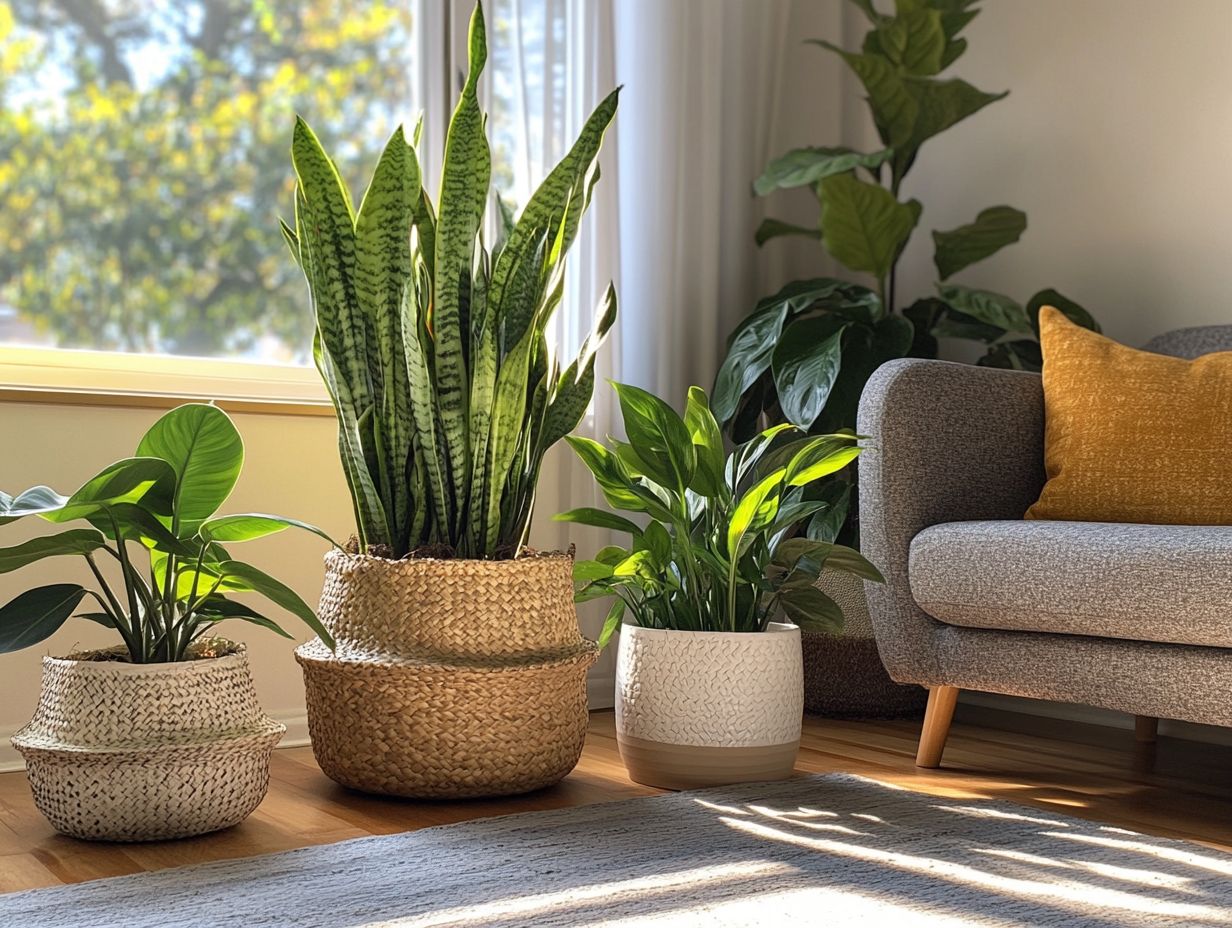
Common mistakes in growing indoor plants can significantly hinder their growth. Overwatering and insufficient light exposure are frequent missteps.
Many plant enthusiasts overlook the unique needs of each species. This often leads to choosing plants that aren’t suited for their home’s lighting conditions. Researching the light requirements of each plant is essential, especially when considering options like the top 5 indoor plants that bloom. This knowledge helps you place them in spaces that align with their needs.
Some plants thrive in direct sunlight. Others prefer indirect light or shade. Using sheer curtains can diffuse harsh sunlight during peak hours. This protects delicate leaves from sunburn and fosters healthy growth.
Regularly monitor moisture levels and adjust your watering habits. This will maintain your plants’ vitality.
Can Indoor Plants Survive Without Natural Light?
While most indoor plants enjoy natural light, some resilient varieties can thrive in low or no light conditions. These are ideal for darker spaces like bathrooms.
Consider the remarkable Snake Plant and the ZZ Plant, both champions of survival. They can endure neglect and flourish in minimal light. The Snake Plant purifies the air and needs watering only when the soil has completely dried out. For those living in tight spaces, exploring options like the top 5 indoor plants for small apartments can be a perfect low-maintenance choice!
The ZZ Plant, with its glossy leaves, is equally forgiving. It demands infrequent watering and tolerates various conditions. To help these plants thrive, provide well-draining soil and avoid overwatering to prevent root rot.
Regularly dust their leaves to enhance their ability to use sunlight to make food. This makes them not just survivors, but thriving beauties in your home.
How Can One Incorporate Indoor Plants into Their Home Decor?
Incorporating indoor plants into your home decor elevates the aesthetic appeal and infuses life into your spaces. This creates a harmonious balance between nature and interior design.
When selecting the right plant, consider the unique characteristics of each variety. Think about how these can enhance your decor themes. For instance, sleek, modern pots can beautifully accent minimalist or industrial interiors. Meanwhile, textured ceramic options may suit rustic or bohemian styles.
Arranging plants at varying heights using stands or shelves adds visual intrigue. This guides the eye throughout the room and fosters a more engaging interaction with your environment.
Grouping plants with similar care needs simplifies maintenance. This allows for playful combinations showcasing delightful leaves and colors, transforming indoor gardening into an enjoyable and visually captivating experience.
What Are the Best Places in a Home to Display Indoor Plants Requiring Natural Light?
Identifying the optimal spots for your indoor plants that crave natural light is essential for their growth. Consider sunny windowsills and bright corners as prime locations for your green companions.
These areas typically enjoy direct sunlight for parts of the day. They are perfect for sun-loving plants like succulents and cacti that thrive in such conditions. Rooms with south-facing windows are particularly advantageous, as they bask in abundant sunlight. For those looking to enhance their indoor space, consider the top indoor plants for varied lighting, which create an ideal backdrop for vibrant foliage like snake plants and pothos.
To ensure your plants bask evenly in the light, regularly rotate them. This allows every side to soak up those precious rays. Keeping your windows clean and unobstructed significantly enhances brightness, creating a more inviting environment for your flourishing greenery.
What Are the Benefits of Having a Variety of Indoor Plants in a Home?
Having a variety of indoor plants in your home enriches your living environment and offers numerous benefits, such as improved air quality, enhanced mood, and greater visual interest.
When you select a variety of plants, you create a dynamic atmosphere that elevates the ambiance of any room. For example, plants like the peace lily and snake plant act as natural air purifiers, absorbing toxins and releasing oxygen. If you’re looking for more options specifically suited for your space, check out the top 5 plants for northern windows, leading to a healthier home you’ll love!
The interaction among different plants cultivates a sense of tranquility and balance, positively influencing your well-being. Diverse plants bring seasonal changes that keep your decor vibrant. From the bright blooms of spring to the lush green foliage of summer, each season contributes its unique charm, ensuring every visit to your home feels fresh and inviting.
Frequently Asked Questions
-
What are the top 5 indoor plants that thrive in natural light?
The top 5 indoor plants that thrive in natural light are the spider plant, aloe vera, snake plant, peace lily, and jade plant.
-
How much natural light do these plants need to survive?
These plants need at least 4-6 hours of indirect natural light per day to survive.
-
Can these plants also tolerate low light conditions?
Yes, most of these plants can tolerate low light conditions, but their growth may be slower and their leaves may become lighter in color.
-
Do these plants require a lot of maintenance?
No, these plants are relatively low maintenance and only need to be watered once a week or when the soil is dry to the touch.
-
Can these plants also purify the air in my home?
Yes, these plants are known for their air-purifying abilities, making them great additions to any indoor space.
-
Where can I purchase these plants?
You can buy these plants at your local nursery, garden center, or online. Just make sure to choose healthy, well-established plants for the best results.
Start your indoor garden today and bring life into your home!

